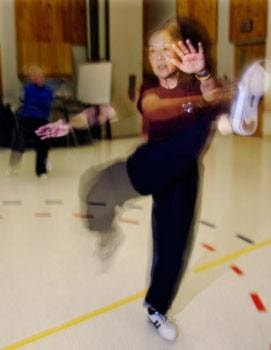Pam Boyde’s tai chi has come a long way since she started in Whitehorse nearly 20 years ago.
“At that time it was the Beijing 24, that’s what was popular,” said Boyde on Wednesday evening, before teaching a class at Elijah Smith Elementary School.
The Beijing 24, a series of moves that became a standard promoted by the Chinese government, was taught to workers, soldiers and even schoolchildren.
If you’ve spotted seniors in the park doing slow, flowing exercises, it’s probably the old standard.
“It was a good beginning,” said Boyde. “I think it’s whatever you’re exposed to, and what you decide to follow… tai chi overall is such a wonderful form of exercise — it’s a martial art.”
After watching a skilled tai chi practitioner, it’s easy to see the parallels between the slow, flowing arcs of tai chi and the fierce explosiveness of more outward martial arts.
“Tai chi is kung fu!” said Boyde. “Kung fu literally means attaining a high level of ability … skill. You could have kung fu in music, for example. Because of Kung Fu, the TV show, people think it’s just fighting (that martial art is properly known as wushu).
If that’s the case, then Boyde is gaining serious kung fu within the Yang family style of tai chi.
Last month, she became the first Canadian to be certified as an instructor with the International Yang Family Tai Chi Chuan Association.
The certification comes after five years of instruction with the Grand Master Yang Zhendou, the fourth generation of the Yang family to teach tai chi, and his grandson Yang Jun.
Initially, Boyde learned the Yang style from videos, along with other members of Tai Chi Yukon, and they struggled along as best they could.
When Yang Jun opened a school in Seattle in 2002, Boyde jumped at the chance to learn from the source.
Her first lessons at the Seattle centre were with the Grand Master Zhendou himself, and it would be the last time he would travel to teach outside China.
“I was very fortunate, he was close to his 80s.”
Boyde would become a familiar face at the centre.
“Each year I trained with Yang Jun, so he was getting to know me a little — it’s helped me so much, I just grew so much in understanding the form.”
Yang family style was the basis for the Beijing standard; it remains the most popular of the five main forms of tai chi.
When the Grand Master celebrated his 80th birthday in 2005, more than 100 international students made the trip to Tai Yuan in Shanxi province in China.
“Zhendou was so touched that so many of his students showed up, that he came out of retirement to teach again, and that was my second chance to learn from him,” said Boyde.
“I decided, since I was there, that I would try for my rank, and I got permission to try for a level four, an intermediate level.”
Up to that point, Boyde had no way to gauge where she was at in her training.
She successfully achieved that ranking, and this summer she returned to try for the level five.
After another successful challenge, Boyde decided to approach Yang Jun about becoming a certified instructor.
“Like the ranking, it’s something for myself- to know that all the practice and study, which is done, more or less in isolation … it gives me confidence that what we doing here is not far off the mark.”
Teaching has made her a better practitioner — “When you teach, you need to be able to articulate it, so it pushes you to a higher level of understanding in the practice, but there’s lots of room to grow, I have so much more to learn.”
What is it about the exercises, the working with chi, that keeps people involved for a lifetime?
After 20 years, it’s still hard for Boyde to describe.
“Over time, people can start to put their finger on it, but in the beginning, it just makes you feel good,” said Boyde. “How do these slow, round movements make you feel, by the time you’re finished, more energized and yet so relaxed?”
That’s a mystery that Boyde will be happily solving for the rest of her life.
Pam Boyde is teaching the traditional Yang-style 103 movement hand form, among others, Tuesdays and Thursdays at Hidden Valley School.
For more information contact Tai Chi Yukon at 633-6034 or surf to www.taichi-yukon.ca
